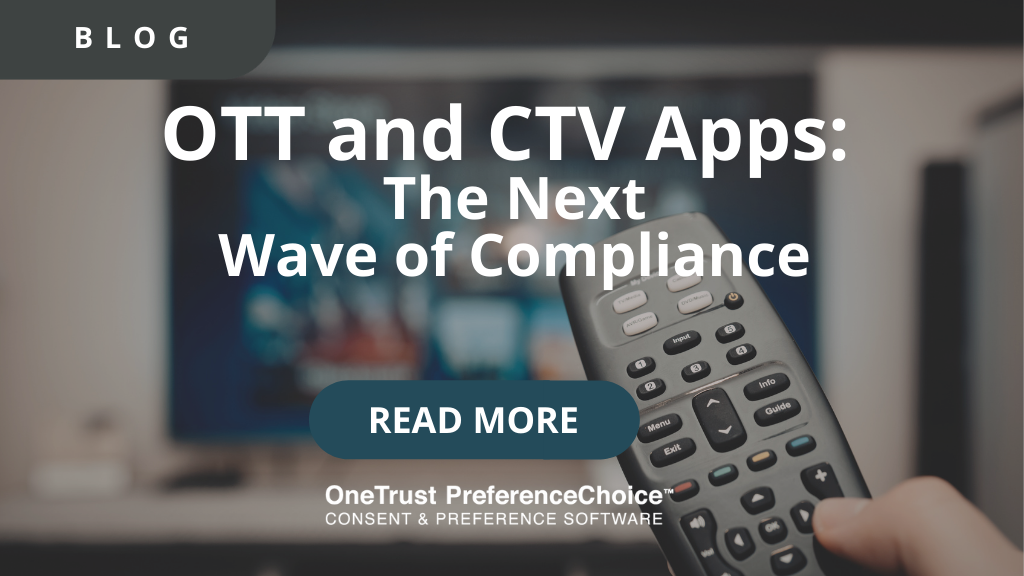OTT and CTV Apps: The Next Wave of Compliance
by Grace Dillon on 4th Mar 2021 in News


Connected TV (CTV) and Over-the-Top (OTT) applications represent the future of entertainment. It's expected that by 2022 55 million people will “cut the cord,” or eliminate cable completely. And with more people home-bound due to COVID-19, Connected TV inventory has increased by 54%.
TV streaming presents a variety of opportunities to achieve a new level of precision in TV buying. Publishers and advertisers can gain a better understanding of who’s consuming content and from what devices.
But with more data comes more responsibility.
Ad tech vendors and publishers offering advertising in the OTT landscape need to become increasingly prepared for the next wave of privacy compliance, which will undoubtedly regulate OTT. Regulations, frameworks, and tech changes have impacted web applications and mobile devices, so it’s common sense OTT and CTV will join the privacy discussion soon.
The question is, how will OTT and CTV providers comply with these privacy changes and how will that impact advertisers and publishers? Read on to find out.
OTT Compliance Wave
We’ve seen several waves of privacy compliance. The first wave impacted web properties and the second wave focused on mobile apps. Now, we are at the onset of the third wave, Over-The-Top (OTT) app compliance.

What Are Over-the-top Services and CTV?
Over-the-top (OTT) Services broadly is any service that bypasses cable, satellite, broadcast, or cellphone carrier networks. For the purposes of this blog we’re refereeing to over-the-top TV (OTT TV) as a video content service broadcasted over the internet. This content is accessible on laptops, mobile devices, tablets, or connected TV. Streaming is what really singles out OTT video content as it means users don’t pay for subscriptions to traditional television or cable providers. OTT Services include but aren’t limited to:
- Streamed video-on-demand services (VOD) – Services typically offered through a tv provider that allows users to purchase access to multimedia content for a limited time period
- Subscription video on demand (SVOD) – Platforms such as Hulu, Netflix, Disney+, and Amazon Prime Video that offers users unlimited monthly access to streaming content
- Advertising-based video on demand (AVOD) – This type of streaming include content consumed on platforms like YouTube and Facebook that provide consumers access to content “for free” in exchange for advertising views
- OTT Communications – Real-time communications that operate over the internet or cell phone data such as WhatsApp, Facebook messenger, Skype, amongst others.
Connected TV (CTV) covers the devices that offer multimedia support and can connect to the internet. Think of CTV as the middle ground between traditional TV and computer technology. It integrates all internet and web 2.0 functionalities to create an interface similar to smartphones, which is why it’s referred to as smart tv.
Both OTT and CTV help users to stream video content over the internet. Often, you can use them together. For example, many use their Xbox (CTV) to watch Netflix (OTT).
Users typically view OTT content via CTV. Think of OTT as the method for delivering video content and CTV as the device used to watch the content.
OTT Streaming Consumption Trends
Generally speaking, market trends have shown a shift towards in multimedia consumption. In fact, 64% of American households opting out of cable services and moving towards OTT services. This shift to OTT services has only been further heightened by the COVID-19 pandemic. The number of consumers with connected TV (CTV) inventory increased from 54% from April 2019 to April 2020. Notably, Recosense Infosolutions estimates that the revenue generated by OTT services will reach more than 58 Billion by 2024.
Companies are setting out to build their own OTT applications to meet the increasing digital demand for streaming content. As a result, organisations will face the challenge of implementing a solution for OTT consent management. In the webinar, OTT App Compliance Providing Transparency and Choice to Video Streamers, Stephanie Hanson, OneTrust PreferenceChoice Offering Manager explains the OTT landscape and how companies can stay up to date.
What Regulations Impact OTT Services?
The number of privacy legislations, standards, and frameworks is growing and evolving in response to consumer demand. The ePrivacy Directive and the proposed ePrivacy Regulation are the most prescriptive pieces of legislature when it comes to OTT services. Most recently the ePrivacy Directive updated the data controller’s obligations to encompass OTT services from December 21, 2020. Prior to this OTT services were not covered in the ePrivacy Directive.
Although CCPA and GDPR do not explicitly address OTT streaming, this does not mean business should completely overlook incorporating privacy into OTT product design. As the use of OTT services increases, we can expect to see more regulations and updates that will address privacy and compliance evolving alongside OTT technology. In the mean–time, organisations should transparently disclose data processing and capture consent within reason.
Common OTT Compliance Use Cases
Businesses should provide consumers with an option to opt-out of the sale of their data when setting up their account and also make updating their preferences accessible any time after set up. This is the most relevant to CCPA compliance. When considering OTT compliance and the CCPA’s opt-out requirement, businesses should provide consumers with an option to opt-out from the sale of their data in the settings menu.
Although OTT compliance is not widely adopted in the EU yet, we expect to see an increase in compliance moving forward. Most notably, the recent ePrivacy Directive updates coming into effect in December 2020. One method to ensure GDPR and OTT compliance is by providing an expandable banner option for data subjects to opt-in to data collection.
OneTrust and OTT Compliance
Ideally, OTT compliance should sync from mobile and tv applications. By implementing drop-down device sync at a granular level, businesses can ensure cross-device compliance for OTT services. OneTrust OTT App Compliance assists businesses with collecting and storing consent and preferences within Smart TVs, Over-the-Top (OTT) applications, and CTV environments.
To learn more about how OneTrust PreferenceChoice can support OTT and CTV compliance request a 1:1 demo with one of our experts.








Follow ExchangeWire